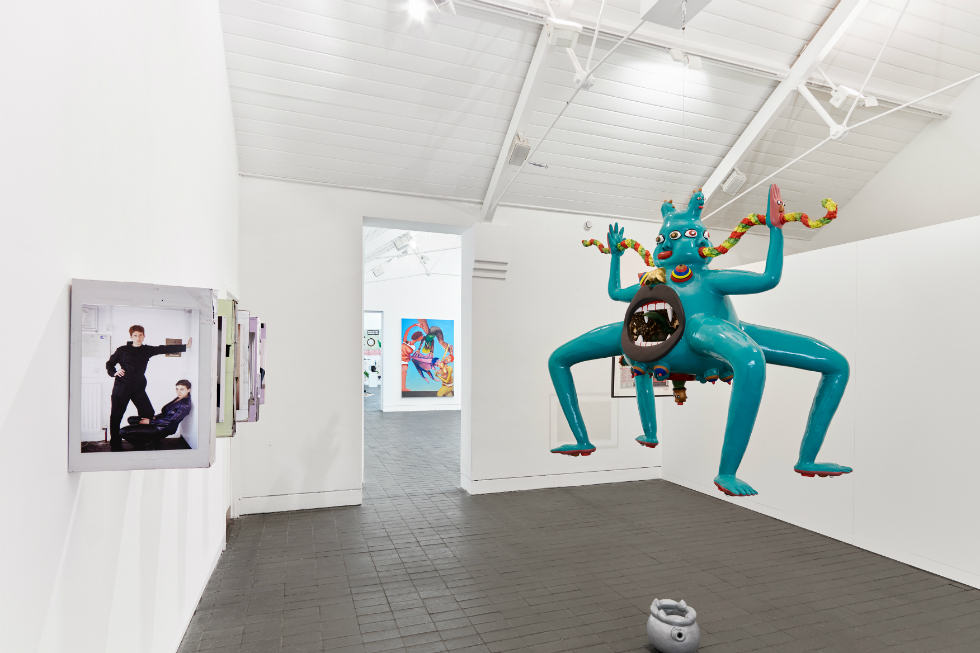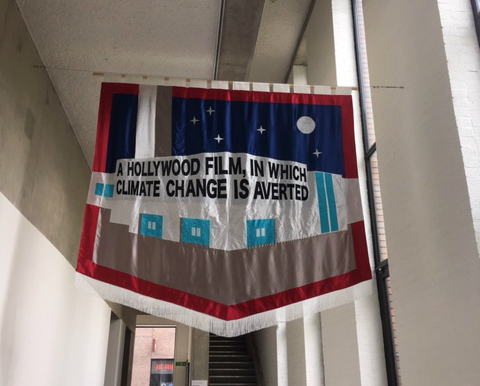“A showcase and a kind of challenge.” Survey – Reviewed

How to test the water of contemporary art? Jerwood Art’s Survey, on display at the Bluecoat, sets out to do just that. Mike Pinnington reviews…
Opening last year at Jerwood Arts, Survey – “the largest review of contemporary art practice” in their history – brought together 15 early-career artists based in the UK. Selected by head of programme, Sarah Williams (from nominations made by slightly older heads including Rachel Maclean, Pil and Gallia Kollectiv and Ryan Gander), works cover many disciplines – sculpture, film, painting, drawing, collage. The wide-ranging show, on display at the Bluecoat in Liverpool since April, offers another opportunity for exposure to this group of artists still finding their way.
Anyone familiar with the layout of the Bluecoat will know that its exhibition spaces can seem somewhat awkward, and can pose a problem to natural rhythm or flow for the audience. That the first work encountered is film, then, feels quite a brave decision. Even regular art gallery visitors won’t necessarily have the proclivity or patience to enter a black box and sit in front of moving image work on arrival. I’m not certain either that, if they do, they would feel rewarded by Anna Raczynski’s film The Movie Makers, about an amateur film group based in Colne, Lancashire. Documentary in style, it deals with the passage of time, the ageing process and community. It has something of the feel of so-called Slow TV about it, a genre that is allowed to unfold in real time, and relies on the relative endurance of the viewer – only here, you don’t have the option of putting the kettle on and coming back to pick up where you left off.
Emerging into the light, you meet A Track with No Name, a pair of images by Simeon Barclay (another, Decoy, awaits in gallery 4). Concerned with identity, popular culture, its dispersal and potency, Barclay’s appropriation of photography and use with text in collage seems to owe something to figures such as Barbara Kruger, who employs the seductive visual language of advertising so effectively. His work in Gallery 4 even drops that word – seductive – as if to literally spell out the subtly dangerous allure of mass media imagery. His works are something of a throwback, then, but no less welcome for that. Further along this long corridor-like space there hangs, like an old trade union banner, Chris Alton’s A Hollywood Film, in which Climate Change is Averted. It’s a clarion call for a bigger, louder transmission of the defining issue of our time. That it asks for the platform to be Hollywood points, perhaps (somewhat sadly), to the sense that the problem confronting all of us will be rehearsed/dealt with in fiction before and after the catastrophe that surely awaits.

Stepping into Gallery 2, all around there are works of different sizes and description, and the space is host to six artists – on the wall to your left are Will Sheridan Jr’s Ownership Boxes. Made from discarded cardboard found in London’s affluent Mayfair district, they have been repurposed and mounted with photographs to mimic our bombardment by fashion ads. I know this because I read the leaflet that you can pick up at the entrance to the show, but for those who don’t like to refer to physical texts as they walk, getting under the skin of this exhibition is probably on the challenging side. Contemporary art can be difficult, and I feel a small rethink of interpretation would have been useful and generous here. How much effort would it have been to include a short caption next to each of the artists’ work, for instance?
One of my favourite works in the show is The word of mouse (grok your cornea gumbo), a film by Thomas Goddard. Employing both moving and still archival images, it picks up the threads of Barclay and Sheridan Jr, in that the theme is one of the pressures and messaging we are subject to in our day-to-day lives. Here, it is the realm of digital culture and the split between on- and offline life that comes under scrutiny. Old TV pizza restaurant ads proliferate, as we passively watch, perhaps feeling our tummies rumble. When these are replaced with a multitude of social media food posts, with the attendant ‘likes’, ‘hearts’, smile and frown emojis, there is almost a pang of nostalgia for simpler, more passive times: “this is what you like because we tell you to like it.”
How little we anticipated a world in which #food and #yummy would proliferate quite so much. The visuals are accompanied by an original and effective – occasionally sinister – soundtrack, with hints of ASMR, although not gratuitously. (I make this point because ASMR’s recent usage is becoming so ubiquitous in contemporary art as to risk terminal fatigue.) A thought-provoking film that highlights the gulf in difference between the virtual and ‘real’, the quick, choppy edits (also featuring nature alongside the virtual) means a bigger, subjective picture, must be pieced together by the viewer, depending on particular experience. The film closes with the line “Close your eyes, it’s time for us to dream,” perhaps warning that, despite appearances to the contrary, we are in danger of sleepwalking through the lives we inhabit.
Dominating Gallery 3 is the in your face boldness of Rae-Yen Song’s Happy Happy Leaf, a kinetic sculpture that is suggestive of new age religious iconography. With hungry gnashing teeth in a mouth where its belly should be (the inside of which is decadently gold in colour), breasts for eyes – or vice versa – and udders, beneath it sits a pot, containing who knows what. it is an incongruous and beautiful thing. The centrepiece for an “as-yet unrealised array of objects, documents and practices” assembled in a celebration of music and dance, I look forward to seeing more. Nearby, Frank Wasser’s 02.11.20 looks into the future via the pages of tabloid freesheet the Metro. It’s a brave decision on the part of the Bluecoat to have its mocked-up front page facing the window, no doubt catching the eye of many a passer by less interested in art as they are in the sensationalist headline, which screams “Trump Assassinated.” Arguably a cheap shot, it is nevertheless well executed, pardon the pun, and timely (Trump just confirmed his decision to run for the next presidency), and one wonders how many people quickly googled the headline to check its veracity.

Ascending the stairs into Gallery 4 and the final section of the show, the room has a theatrical air. Hazel Brill’s floor bound We gathered around the puddle, smiling patiently hints at the therapeutic quality of water and nature, even when their setting is an urban one. On the wall behind, Emma Cousins’ mural and framed drawings make up Arpeggios, a tribute of sorts to bodily frailty. The simply rendered figures do a lot with a little, their faltering forward motion suggesting a kind of acknowledgement of the human condition. A pair of headphones hang from a stage-set of sorts in Milly Peck’s Landing Good Sync Will Pay Dividends. On the soundtrack, food is noisily munched, Sellotape unspooled and plates clatter resoundingly in a work inspired by the anonymous Foley artists who produce sound effects for film, TV, radio et al. This peek behind the curtain of post-production ingenuity that we rarely otherwise consider makes for a playful endpoint to Survey.
With the ostensible unifying factor being the works’ inclusion by nomination, you necessarily have to judge each almost in isolation, rather than wondering about thematic decisions regarding their suitability to appear together. There are, however, commonalities running throughout, sprinkled like curatorial breadcrumbs, allowing the visitor to make their own connections and observations. A time capsule of sorts, it is at once a showcase and a kind of challenge – it will be interesting to see the respective responses, how and whether those included develop.
Mike Pinnington
Survey @ the Bluecoat closes 23 June
Images from top: Survey installed @ Jerwood Space, London, courtesy Anna Arca; Chris Alton, A Hollywood Film, in which Climate Change is Averted and Emma Cousins, Arpeggios (both photographed by MP)





